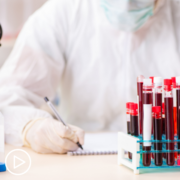Low-Risk Versus High-Risk AML
Low-Risk Versus High-Risk AML from Patient Empowerment Network on Vimeo.
How is AML risk determined, and how does it affect treatment options? Dr. Ann-Kathrin Eisfeld defines low-risk and high-risk AML and explains how this classification may predict disease response to therapy.
Dr. Ann-Kathrin Eisfeld is Director of the Clara D. Bloomfield Center for Leukemia Outcomes Research at The Ohio State University and a member of the Leukemia Research Program at the OSUCCC – James. Learn more about Dr. Eisfeld.
Related Resources:

|

|

|
Transcript:
Katherine Banwell:
Many cancer types are typically staged. But that’s not the case with AML. AML is often considered low risk or high risk. Is that right?
Dr. Eisfeld:
Yes. And we – I think that’s very well how you put it. And we can even – they even add an intermediate risk by now to it. And I love this question because that’s what I like to study or what I’m studying here. The one important thing to keep in mind – and this is something even many hematologists don’t think about –
– is that the risk assignment of acute leukemia, of AML if you think about it as low, or high, or intermediate risk is risk – or is actually better said not risk, but chances to respond to conventional chemotherapy. So, the way all this was defined is that if you have, for example, a multitude of chromosomal abnormalities – as you call it complex karyotypes – it would be considered adverse. This means your chances of responding to the standard of care in terms of chemotherapy are very, very low.
And similarly, if you have other changes such as a NPM1 mutation, your chances are considered very high. And but – so, the risk assignment with the increase of treatments now changes. We still also – and when I look at that, I think about it in the same way. But in my mind, if I’m talking to a patient, I’m trying to make sure to say, this is considered an intermediate or adverse risk.
But this means that I would not, at the first place, consider you for a standard chemotherapy but rather advise you to participate in a clinical trial or have an alternative care. The second implication especially for younger patients would be to – if you’re intermediate or adverse risk, that you would routinely be considered for bone marrow transplant or stem cell transplant.
Katherine Banwell:
Okay. So, what does it mean to be high risk then?
Dr. Eisfeld:
It means that your likelihood of going into remission – the standard of care is very low.
This means – I mean, in very practical numbers, it might be as low as 20 or 30 percent. This meaning getting the leukemia into remission, there are very important differences. The first step at every time in the same high risk means if the patient receives the treatment, how high are the chances that we can get rid of the leukemia?
The second question is how high are the chances once it’s gone that it stays away? Or how high are the chances of relapse? In adverse risk most cases, it’s both – a combination of those. The chances of going into complete remission are lower and the chances of it coming back are higher. So, we have to be very aggressive. This means that we have to consider alternative treatment options. And even if we are then lucky and achieve remission, that we might have to move to more intensive additional treatments such as a bone marrow transplant.










